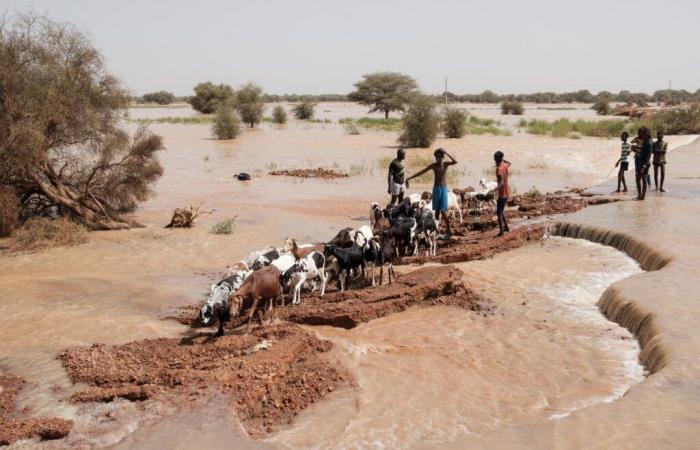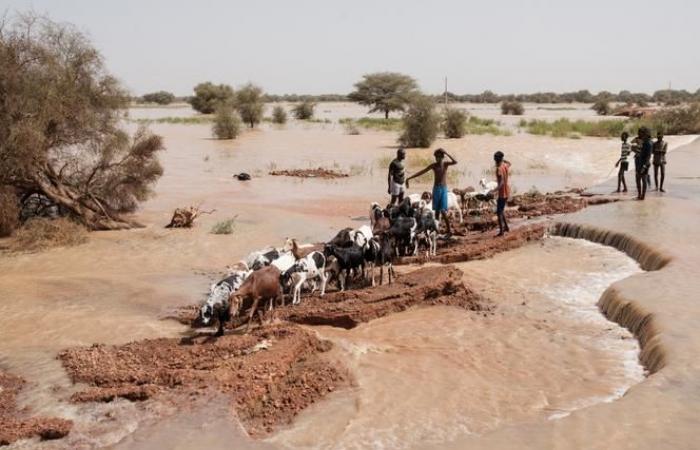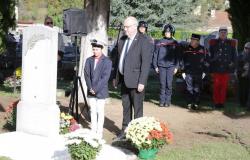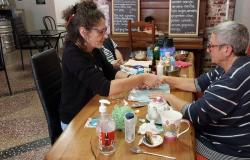“Time stood still on October 12 at 10:30 a.m.”says Samba Gadiaga, frozen in the middle of his devastated property. In Ballou, as in twenty other villages in the Bakel department, in eastern Senegal, it was like a long, slow tidal wave. Nearly 56,000 people lost their homes, their land, often both at the same time, according to an official report given on October 31 and still provisional. Hundreds of thousands of hectares were covered by water and still are.
The damage is concentrated on a strip of land hundreds of kilometers long on the left bank of the Senegal River. Hastily, a dike was built in the large coastal city of Saint-Louis to try to prevent flooding, as the floods continued to move northeast, further downstream from the Senegal plain. or the agricultural regions of Matam and Podor, also strongly affected.
Read also | Senegal: in Dakar, residents are fed up with repeated floods
Read later
From the roof terrace that became Noah's ark for forty-four children, Samba Gadiaga remembers those ten days when the carts were floating and the donkeys had disappeared from the streets; canoes were then necessary to obtain supplies. Today, all that remains for this farmer dressed in a blue boubou is to contemplate his rice fields ravaged by the waters of the Falémé, one of the tributaries of the Senegal River.
Houses collapsed like houses of cards
“This succession of flood peaks, between the end of August and mid-October, saturated the soil, says Andrew Ogilvie, hydrology research fellow at the Research Institute for Development, in Montpellier. The Senegal River basin could no longer absorb anything. It is not the violence of the urban floods in the Valencia region [qui ont fait plus de 200 morts en Espagne]but the effect is cataclysmic for hundreds of thousands of Senegalese living on this land”.
Read also | Article reserved for our subscribers In Valencia, Spain, the anger of residents after the floods: “Our politicians did not understand what was happening”
Read later
After these torrential rains late in the season – one of the effects of global warming – the power of the Senegal River was increased tenfold by water releases at the saturated Manantali dam, one of its tributaries in Mali. The watercourse left its bed, the laterite tracks then became inaccessible. Electricity pylons, telephone relay antennas, grocery stores, agricultural machinery, schools, and thousands of homes made of banco – a material made of clay and straw – were damaged or, more often, collapsed as house of cards.
Very quickly, help was organized: volunteers, neighbors, canoeists from Bakel, businesses and even residents of Dakar, 700 km away, mobilized and numerous solidarity caravans were launched. A heavier human toll was thus avoided, although a 7-year-old girl was found drowned in Kidira, on the border with Mali. The State has not remained inactive, but, if it is trying to manage aid today, its awakening was late and still insufficient: only eight large tents for refugees were installed on October 18, i.e. six days after the disaster, according to an official document consulted by The World.
Three weeks after the start of the floods, astonishment and a feeling of abandonment remained widely shared on this strip of land bordering Mauritania and Mali. Met on Wednesday October 30, an old man in a red keffiyeh was sitting in the courtyard of a town hall whose roof had been blown away, waiting for two hours for an improbable renewal of the civil status certificate.
Bassirou Diomaye Faye's visit criticized
After the exceptional aid of the first days, the mobilization of the authorities is struggling to relieve the needs. “I would need 3 million CFA francs [4 596 euros], or the work of several years, to rebuild”explains, trowel in hand, Boubacar Marega, alone, facing his house in ruins. The Senegalese government promised on October 16 to release 12 million euros, but this seems insufficient given the scale of the projects.
Worse, the arrival on October 19 of the Head of State, Bassirou Diomaye Faye, in fatigues and dark glasses, fueled the anger of the victims by going only to the two rehousing sites and not where the inhabitants were the most hit hard. In Golmy, the epicenter of the disaster, Ahmed Traoré's bitterness increased tenfold after his meeting with the president. “I told him it’s a shame to live so isolated, said the retiree from a hypermarket in France, returning to his native village to spend, he thought, some quiet days. His attitude is incomprehensible, he only stayed on dry land, only to leave as quickly by helicopter and only fly over the flooded areas.”
Read also | In Senegal, President Bassirou Diomaye Faye visits flooded areas in the east and north of the country
Read later
Cheikhna Camara, the mayor of the neighboring town of Ballou, also does not hide his anger towards the new authorities – “nulls and incapables” – and rails against their lack of anticipation. “During the interministerial meeting of August 26, I told the Prime Minister [Ousmane Sonko] that the alert level had been exceeded and that the Orsec plan had to be triggeredspecifies Mr. Camara, invited to the meeting as vice-president of the association of mayors of Senegal. But nothing was done! The lights were red and they looked elsewhere.”
For now, he and all his neighbors continue to clean, clear away, scrub what can be scrubbed, while the specter of a health disaster looms. In the backwaters occupying half of the village of Golmy, donkeys graze in the muck of an open-air dump mixed with stagnant water. The floods covered fresh water wells and no order was issued to prohibit their consumption or domestic use.
“We have lost the sense of danger”
“Bleach tablets to disinfect water” were distributed, specifies Yassine Gueye, the head nurse. In what quantity? The data provided by the Bakel prefecture does not specify this. Alone “around ten cases of diarrhea” were recorded by the one and only caregiver per 10,000 inhabitants. “Without being alarming, these are weak signals that we monitor “, she said.
Follow us on WhatsApp
Stay informed
Receive the essential African news on WhatsApp with the “Monde Afrique” channel
Join
Dispatched to the site, the firefighters had still not pumped, on October 31, the thousands of hectares still flooded, raising the risk of the spread of diseases such as cholera. Aware of the risk, the prefect of Bakel believes that the “80,000 liters of drinking water” sent from the first days made it possible to avoid a disaster of a completely different scale for the 35,000 most affected victims.
Read also | In Senegal, the government presents its major development plan
Read later
Trapped by the waters, the inhabitants now see their future hampered on these lands marked by decades of drought, another effect of global warming. “Unlike the floods of 1974 [qui avaient fait moins de dégâts], we have lost the sense of danger by building in flood zones, underlines Boubou Lasana Camara, the village chief of Golmy. It was a fatal mistake. » In Golmy and Ballou, the upper parts, built before the 1970s, were spared. Perched on a mountain, built on the sweat and blood of thousands of forced workers in the 19th centurye century, the colonial fort of Bakel, today occupied by the prefect, has never been threatened by floods.







